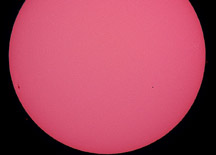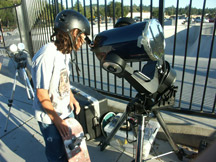The 2006
Mercury Transit
Nov 8 was a special day.
Only the second transit of Mercury visible from California during the 44 odd
years I've been into astronomy, and the last for another 10 years. The winter's
first significant cold front arrived this day, but the front itself crossed
Santa Cruz at the start of the transit - 11am - and skies cleared. Jay arranged
for his son's home school group to meet us at Sky Park in Scotts Valley. Astro
9'rs Eric and Jonathan also joined in. I set up the 8" with solar filter
and spend most of the central 3 hours showing kids the sun and the little black
spot. Jay was busy with his solar oven baking chocolate chip cookies (not too
successfully, advertising notwithstanding- but at least the gooey cookie dough
got sort of warm, and still tasted good), and hooking up his Coronado H-alpha
scope and electronic eyepiece to a TV monitor.
Elsewhere, Chris Angelos
observed from San Jose after getting freaked out by the clouds, and Chris Kitting
watched and photographed from home (missing both ingress and egress due to horizon
problems). Chris K sent along this nice image from his backyard in the hills
above Hayward. Allen Ginzburg also watched and photographed from home.

Astro 9 veteran Allen Ginzburg snapped this shot white
light image using his Meade 10" LX200 and Nikon 4300 digital camera
from his front yard in Aptos. |

Chris Kitting's pleasantly pink H-alpha sun, a major sunspot group
on the left, and Mercury right center. Takahashi TOA 130mm aperture
f/7.7 refractor (1000mm focal length), Nikon 2x teleconverter 301, and
Nikon 10-MP D200 digital SLR. 1/250 sec at ISO 800 (through Coronado
90mm 0.7-A H-Alpha filter) and 1/3200 sec at ISO 125 through Baader
thin Photo film. Stack and Photoshop Curves of two frames, using Keith’s
Image Stacker Software on a Mac Powerbook Computer, for a composite
of red and white spectra. North is up, when image is horizontal, with
noticeable small prominence at right edge, as now. A coronal mass ejection
(separated prominence) is near left edge. © 2006 by Christopher
L. Kitting, Ph.D. Cal State U. East Bay, Hayward CA.
|

Chris Kitting got this image later in the transit, cropped from full
frame sun, via Nik 2x teleconverter. Caption much like my previous Mercury
transit caption, but based on ~3 H alpha and 4 white images, stacked.
Mercury is at far right.
|
And here's some pix from our efforts
at Sky Park. Weather was clear and blustery, and seeing was pretty bad, but
had periods of semi-acceptable stability. Good enough for some camcorder footage.
Lots of eager young minds and curious folk to entertain and educate. It was
a wonderful afternoon!

Jay's son and his Home School group look at the sun in the solarscope
box
|

Meanwhile, I set up the 8" Meade and Thousand Oaks solar filter
for a direct view... bringing lots of smiles
|
 |
 |
|
|
|

Local skateboarding wastoid examines Jay's H-alpha scope
rig |

Hmm. This looks like genuine curiosity. Maybe not a wastoid??
|

With final egress approaching, the kids went off to play soccer and
we prepare for some serious imaging. Jay adjusts his camcorder feed.
|

That's me, photographing the live H-alpha video signal
from Jay's Coronado scope. JC is behind me. See Mercury...? |

Eric's 8" w/Nikon had challenges dealing with tiny
Mercury. |
Eventually, both Jay and I will
download our miniDV footage and produce .avi files, then run that through Registax
and produce some images of Mercury. As reminder, I'll include an empty frame
set...















